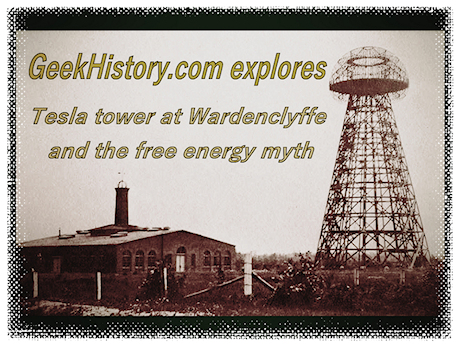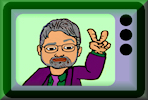 As we dig deeper in researching topics here at GeekHistory the one topic that people keep asking questions about is Nikola Tesla's tower at Wardenclyffe and his free energy theories. We have addressed many of the commonly asked questions in this article.
As we dig deeper in researching topics here at GeekHistory the one topic that people keep asking questions about is Nikola Tesla's tower at Wardenclyffe and his free energy theories. We have addressed many of the commonly asked questions in this article.
Wardenclyffe New York 1901
Nikola Tesla sold his Wardenclyffe tower idea to J.P. Morgan based on a plan to send wireless messages to Europe and compete with Marconi. The contract was agreed upon in February of 1901 and signed in March for Morgan to give Tesla $150,000 to build a tower to transmit radio. Tesla began to build his Wardenclyffe laboratory on Long Island, New York in 1901.
Soon after construction began it became apparent that Tesla was going to run out of money before it was finished. Tesla underestimated the cost of building the tower, and economic conditions were causing prices to rise for the materials Tesla needed.
Tesla's personal goal was to use the tower for the transmission of power as well as information. Morgan was expecting to make money on radio. The wireless power angle was Tesla’s idea, it was never part of Morgan’s plans. It was never finished because Tesla ran out of money.
Various sources place the abandonment of the project at around 1904. Tesla took out a mortgage on Wardenclyffe with George C. Boldt of the Waldorf-Astoria Hotel to cover his living expenses. Boldt eventually foreclosed on the Wardenclyffe property and the tower was torn down and sold for scrap in 1917. Adding to the Tesla mythology and conspiracy theories was the timing of the demolition of the tower, during WWI. Various stories were told that the tower was demolished on orders of the United States Government because German spies were using it as a radio transmitter or observation post.
Did J.P. Morgan withdraw backing?
There are many conspiracy theories that blame J.P. Morgan for Tesla's failure at Wardenclyffe, stating that J.P. Morgan withdrew support because he saw no way to make money on wireless power.
Tesla's dream tower cost him a lot more than he had planned. Tesla signed a contract with J.P. Morgan in 1901 to receive a total of $150,000. Equivalent to millions in modern dollars, that was a pretty generous offer. That was actually $50,000 more than his initial request.
J. P. Morgan was a ruthless banker, part of the business culture of the late 1800s known as Robber Barons. The Robber Barons were the venture capitalists of their day, the 19th century version of Shark Tank. Tesla sold his tower idea to Morgan with a plan to send wireless messages to Europe and compete with Marconi. Tesla failed to mention the lab included his ideas of wireless power transmission.
Tesla came back to Morgan to ask him for more money at a time J.P. Morgan was having his own financial issues with a panic on Wall Street. When you go back to the bank to ask for more money, after they have already given you a substantial amount, and now you need more money, what do you think your odds of success are?
Tesla pleaded to Morgan for more funds, Morgan said no. It's not that Morgan withdrew his backing, it was he refused to provide additional funding. Morgan had already fulfilled his part of the initial contract. When Tesla came back to Morgan asking for additional funds, what incentive did Morgan have to give Tesla more money?
Why wasn't Nikola Tesla able to raise more funds from investors?
When Tesla walked away from his partnership with Westinghouse he was a rich man. Contrary to many stories that Tesla walked away from his royalty contract with Westinghouse, he did receive a lump sum settlement when he severed ties with Westinghouse in the neighborhood of $200,000. Keep in mind we are talking 1890s dollars, which would be the equivalent of millions of dollars today.
With the War of Currents and his work for Westinghouse behind him, Tesla moved on to begin a new series of experiments. With a $30,000 investment from John Jacob Astor IV, thought to be among the richest people in the world at that time, Tesla begin building a new experimental station near Pikes Peak, Colorado.
The wealthy John Jacob Astor IV gave Tesla the money he used to build the Colorado Springs lab under the assumption that Tesla was going to develop and produce a new lighting system. Tesla instead used the money to fund his lab to experiment with high voltage, high frequency electricity, and the wireless transmission of power. Tesla misrepresented his intentions.
Tesla's biggest obstacle was often himself. Just like he was with John Jacob Astor IV, Tesla was less than honest with J.P. Morgan, as his plan was to concentrate on a system of wireless transmission of power, not a system of radio transmission that he sold to Morgan. Once you burn your bridges with two of the richest men in the world, it's hard to get funding for future projects.
Looking for the lost files of "Tesla`s Latest Wonder"
Some conspiracy theories say that the secrets to the success of Tesla's wireless power ideas are lost. The original ideas of Tesla are not exactly lost. Tesla's ideas were published and patented in the late 1890s. At the end of this article you will find the links to Tesla's patents and the San Francisco call newspaper article from 1898.
The article published in 1898 titled "Tesla`s Latest Wonder" describes, "What Tesla proposes to do now is to transmit almost any amount of power almost any distance without wires, and without loss." Tesla's filed two patents on wireless electricity. Patent US 645576: System of transmission of electrical energy, was filed by Nikola Tesla in 1897, and Patent US 649621: Apparatus for transmission of electrical energy, was filed by Nikola Tesla in 1900. In addition to his patents, Tesla's notes from his experiments in Colorado from around 1899 have also been found, and nothing has been made from them either.
There are numerous unanswered questions regarding Tesla's "free power" ideas. The fact that there are so many questions that need to be answered about the details of Tesla's "free power" shows that Tesla's theories were far from a finished product. Even though wireless electricity is being developed on a small scale, it is still very far from a working system at the level that Tesla proposed.
Tesla's wireless transmission ideas that were attached to the Wardencliffe project were never anything more than just a dream. We could second guess all the "what if" scenarios of how Tesla could have done it better, done it differently, but the bottom-line is, it never became a working system.
There are a lot of great scientists in the world of physics that have access to all these great ideas of Tesla's, you would think that if it were practical they would have been able to create Tesla's dream machine.
The free energy myth
The phrases "free energy" and "make power free" as they are used in Tesla mythology assume that everything about the process is free. Even if Tesla's idea was a reality, he could somehow extract electricity from the earth to be reused, it would be free in the sense that we did not have to burn coal, or burn oil, to fire up a generator to produce the electricity. In that sense there are many forms of "free energy" such as wind power, solar power, and water power. Study the field of alternative energy and you will find many ways to generate "free energy" by avoiding the use of fossil fuels and nuclear power.
But even with "free energy" there is the cost of a system to distribute the electricity. Even if Tesla's idea was a reality, the way to initially create the energy was "free," there would the cost of building transmitters and receivers to make it usable in your home.
Go to your local convenience store, and ask them for a free bottle of natural spring water. What, it's not free? That water came from the ground, and it has no cost associated with producing it! That's right, but there is a cost associated with getting that free substance from the ground to you in a usable form. That's the cost of distribution.
You are free to eat your lunch anywhere you chose, but the lunch isn't free, that you will have to pay for.
Was Nikola Tesla crazy for thinking free energy was possible?
An often used expression is that there a fine line between genius and insanity. Over the course of history there have been many highly intelligent people who have done some very crazy things.
Nikola Tesla and Thomas Edison are often portrayed as bitter rivals because they were on different sides of the War of Currents. But when they crossed paths later in life there are indications that there was some degree of mutual respect between them. Perhaps this bit of mutual respect was because they were both very passionate about their beliefs.
Even when it was becoming obvious that DC (direct current) would lose out to AC (alternating current) as the primary form of delivering electricity to our homes, Edison refused to back off of his belief in his ideas. Edison lost control of Edison Electric because of his stubbornness, and he did some very crazy things during the War of Currents. But Edison was also successful with many inventions, in spite of his stubbornness and compulsive behavior.
After defeating Edison in the War of Currents, Tesla became so obsessed with proving many of his "free power" theories that he lost credibility in the eyes of his contemporaries. Did Tesla's obsessions cross over the line between genius and insanity? Some would say yes. The phrase that would better describe Tesla's obsession with free power is that he was blinded by his ambition.
He who blinded by ambition, raises himself to a position whence he cannot mount higher, must fall with the greatest loss. – Niccolò Machiavelli
Below you will find the links to Tesla's patents and the San Francisco call newspaper article from 1898.
The San Francisco call. (San Francisco [Calif.]) 1895-1913, November 13, 1898
The San Francisco call. (San Francisco [Calif.]) 1895-1913, November 13, 1898, Page 25, Image 25
Below you will find the links to Tesla's patents on wireless electricity.Patent US 645576 System of transmission of electrical energy filed by Nikola Tesla in 1897
Patent US645576 - System of transmission of electrical energy
Patent US 649621 Apparatus for transmission of electrical energy filed by Nikola Tesla in 1900
Patent US645576 - System of transmission of electrical energy.
Graphic made from a 1904 photo of Wardenclyffe in the public domain in the United States
